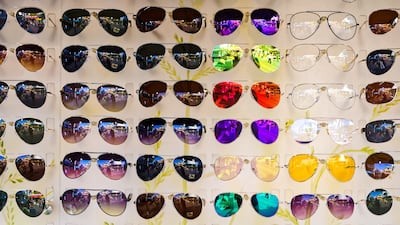Many people my age with lens implants following cataract surgery are thrilled not to have to wear glasses all the time. But I’ve recently gone in the opposite direction. Although, at 78, I can still drive and, in good light, even read the newspaper without corrective lenses, I’ve chosen to wear glasses nearly all the time.
Within the past two years, I’ve invested in multiple pairs of prescription glasses with progressive “transition” lenses, which darken in sunlight to become sunglasses. They provide visual enhancement and protection and serve as a fashion statement. If and when I need to have cataract surgery and require a new prescription, I’ll replace the lenses in my favourite frames and continue to wear them.
Glasses have, in effect, become my jewellery, and I’ve been amazed at how many compliments they inspire. But even more amazing is what the glasses have done for the safety and comfort of my eyes, protecting them from dust, bugs, drying breezes and, most important of all, the damaging effects of ultraviolet light.
UV light has compromised the eye health and vision of far too many people of my vintage, myself included
Although we have been admonished for decades about the need to protect our skin from sun damage, relatively few such warnings have been issued about eyes. As a result, UV light has compromised the eye health and vision of far too many people of my vintage, myself included. I now have an irritating growth called a pterygium on the white of one eye, a result of many decades spent outdoors without proper eye protection.
Happily, things are changing. I now often see babies and toddlers, as well as their caretakers, wearing sunglasses. Still, many people – especially millennials – spend big bucks on sunglasses based on how they look rather than how well the glasses protect their eyes. Yet, you don’t have to spend a small fortune to get sunglasses that can help to keep your eyes healthy. And there’s no time like the present to start doing so.
Ocular sun damage is not limited to summertime or even sunny days. It can occur any time of the year and even when it’s hazy or cloudy. Skiers can fall victim to snow blindness, a temporary impairment. But cumulative exposure to ultraviolet rays can cause permanent damage, including cataracts, pterygiums, premature presbyopia (the inability to see small print), precancerous growths on the eyelids and, current evidence suggests, melanoma of the iris and age-related macular degeneration.
Harmful, invisible rays can reach the eyes from behind, below and the sides, kind of an ultraviolet "surround sound"
People who work outdoors are especially vulnerable, as are those who live at high altitudes. But people with far less exposure to UV light are hardly immune.
Sunlight hitting the eyes directly is not the only source of UV damage. These harmful, invisible rays can reach the eyes from behind, below and the sides, kind of an ultraviolet “surround sound”. UV rays are reflected off concrete, sand, water, ice and snow. Even when facing away from the sun, the eyes are exposed to reflected UV rays.
European experts noted in the journal Clinical Ophthalmology that “under average conditions, more than 50 per cent of ocular exposure results from scattering and cloud reflection”. Clouds and haze increase scattering. The experts called reflected UV an important and underestimated contributor to vision damage.
Also, while we have long been warned to protect our skin when out in the midday sun, peak exposure of the eyes to UV rays depends on the angle of the sun at different times of the year and at different latitudes, and it can occur early in the morning or late in the afternoon.

Children are especially vulnerable to eye damage from UV rays. The lens inside their eyes is still clear and their pupils are wider than in adults, which allows more damaging rays to reach the retina where visual images have to focus if we are to see them. Once the retina is damaged, visual impairment is likely to be permanent.
Here’s what to consider when choosing lenses that can protect your eyes from the hazards of UV overexposure.
All sunglasses should now come with full (400mm) UV protection, although more expensive lenses provide better visual clarity. The colour of the lens does not matter, though light tints are not as effective for people whose eyes are very sensitive to bright light.
Ideally, both regular glasses and sunglasses should have anti-reflective coatings on both sides of the lens
If the label says UV400, chances are it’s true or very close to it. If in doubt about the UV protection afforded by your existing glasses, ask an optician who has a spectrometer to check them.
Ideally, both regular glasses and sunglasses should have anti-reflective coatings on both sides of the lens, which is why I spent a little extra to get Crizal lenses that protect my eyes from UV light coming from behind me as well as from the front.
I also got photochromic lenses in all glasses I might wear outdoors. When exposed to UV, even on hazy days, the lenses darken, then clear in a minute or so when you go indoors. However, photochromic lenses do not darken in a car because windshield glass blocks UV light. And they do not get as dark as dark-tinted sunglasses so may not work well enough for eyes very sensitive to sunlight. But if you wear contact lenses, you can now get photochromic contacts.
You might also consider getting polarised lenses that can reduce glare coming from horizontal surfaces; they’re especially helpful when driving or playing sports. And I recently purchased wraparound sunglasses with shatterproof lenses for cycling, to get better peripheral vision while riding and more protection from UV entering from the sides. – New York Times









